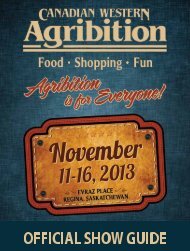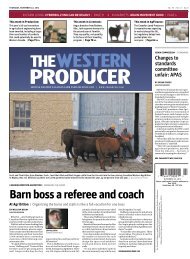Create successful ePaper yourself
Turn your PDF publications into a flip-book with our unique Google optimized e-Paper software.
BY SEAN PRATT<br />
SASKATOON NEWSROOM<br />
Millers are increasingly relying on<br />
Canadian wheat and oats as corn and<br />
soybeans devour acres across the<br />
United States.<br />
Traditional cereal growing states<br />
such as Kansas, the Dakotas and<br />
Minnesota are succumbing to the<br />
corn and soybean tide.<br />
“All of the wheat and oats is being<br />
pushed in a northwesterly vector up<br />
into Canada, and I expect that’s not<br />
only going to continue but probably<br />
accelerate,” Jim Bair, vice-president of<br />
the North American Millers’ Association,<br />
told the Prairie Oat Growers Association<br />
(POGA) convention Dec. 6.<br />
New drought tolerant corn hybrids<br />
performed well in Nebraska and the<br />
Dakotas last year, leading Bair to<br />
believe more wheat and oat acres will<br />
soon be lost in the U.S. to more profitable<br />
crops.<br />
His presentation included a chart<br />
showing that U.S. oat production has<br />
fallen below a million tonnes, down<br />
from 16.7 million tonnes in 1960.<br />
“Virtually every year for the last 30<br />
years, with a couple of exceptions,<br />
we’ve set a new record low in oat production<br />
in the United States,” he said.<br />
Almost all of what is produced in<br />
the U.S. goes into feed markets.<br />
“I’m trying to underscore the importance<br />
of you folks to the U.S. and Cana-<br />
dian milling industries,” said Bair.<br />
In an interview following his presentation,<br />
Bair said Canadian producers<br />
must take up the slack in U.S.<br />
production because food companies<br />
want more oats. Consumption has<br />
been increasing by about five percent<br />
a year.<br />
“Demand is very strong,” he said.<br />
“People are starting to recognize the<br />
heart healthy benefit of oats. It was the<br />
first food in the U.S. that was allowed<br />
to make a heart healthy claim.”<br />
<strong>The</strong> crop is particularly appealing<br />
these days because the shaky economy<br />
is prompting many U.S. families<br />
to try reducing their grocery bills.<br />
NEWS<br />
CROPS | MARKETS<br />
Millers tapping more Canadian crops<br />
Wheat, oat acres falling in U.S. | Corn, soybeans more popular south of the border<br />
Food companies are looking for more<br />
oat crops — and Canada is positioned<br />
to supply them. | FILE PHOTO<br />
“Not only is it heart healthy, but it’s<br />
an inexpensive food,” said Bair.<br />
Private commercial oat breeding programs<br />
are nonexistent in the U.S, which<br />
is why NAMA contributed $510,000 to<br />
the North American Collaborative Oat<br />
Research Enterprise. <strong>The</strong> genetic mapping<br />
research initiative is aimed at identifying<br />
beneficial traits that can be bred<br />
into new oat lines.<br />
“We’re looking at all kinds of things<br />
from increased yields to rust resistance<br />
to looking at the heart healthy<br />
components,” said Bair.<br />
He said the project has been successful<br />
and should put plenty of new<br />
beneficial oat lines in the hands of<br />
producers over the next 10 years.<br />
“That’s going to be super important<br />
to keep oats as a competitive crop,” he<br />
said.<br />
Millers are nervous that the corn<br />
and soybean acreage blitzkrieg taking<br />
place in the U.S. will spill across<br />
the border into Canada. It’s already<br />
happening in Manitoba, where oats<br />
are losing ground to the big two.<br />
“We’re looking at that picture and<br />
saying, ‘look, we better get out in front<br />
of this train and compete and develop<br />
some oat varieties that will make reasonable<br />
crop options for farmers and<br />
at least be in the game,’ ” said Bair.<br />
<strong>The</strong> goal is to develop lines that will<br />
deliver increased profitability for<br />
producers and improved health<br />
attributes for the milling industry.<br />
THE WESTERN PRODUCER | WWW.PRODUCER.COM | DECEMBER 13, 2012<br />
Centennial Column<br />
Celebrating 100 years of students at the College of Agriculture<br />
and Bioresources. <strong>The</strong> Centennial Column is a weekly feature<br />
highlighting the history and present successes of the college.<br />
Wild Boar<br />
Unseen Menace<br />
“Many people in the province simply don’t believe we have a problem<br />
with feral wild boars,” says Ryan Brook, an assistant professor in the<br />
Department of Animal and Poultry Science.<br />
“You often hear people say they would never be able to survive<br />
Saskatchewan winters in the wild. But they are doing very, very well in this<br />
province.”<br />
In this case, ‘very well’ is very bad. Just ask a farmer or naturalist in<br />
Texas, home to about half of the four million feral wild boars in the U.S.<br />
“Feral wild boars are a massive problem in Texas, California, and many<br />
other states,” says Brook. “In Texas alone, the damage to agricultural<br />
crops is $50 million a year. That doesn’t count the $7 million they spend<br />
trying to control their numbers or the ecological damage. <strong>The</strong>y’re a<br />
rooting animal, and people say when they get into wetlands, it looks as if<br />
a giant rototiller has gone through the landscape.”<br />
Wild boars, native to Europe and much of Asia, were introduced to<br />
North America by Spanish explorers in the 17th century. <strong>The</strong>y came north<br />
in the 1970s and 1980s when the fi rst commercial domesticated wild<br />
boar farms were set up. Escapees had no problem adapting to their new<br />
northern home.<br />
“In the last fi ve years, there have been sightings across the province<br />
from Prince Albert and the tree line in the north all the way to the U.S.<br />
border. But we don’t really have a handle on how many there are.”<br />
<strong>The</strong>re’s a good reason for that. Despite their size and the damage they<br />
can cause – one farmer next to Moose Mountain park lost 15 acres of<br />
oats to wild boars in just two days – these highly intelligent animals are<br />
amazing elusive. <strong>The</strong>y are most active in the evening and early morning,<br />
and use their keen sense of smell to both search for food and avoid any<br />
humans.<br />
Brook has obtained some funding from the Cyril Capling Trust Fund,<br />
NSERC, and the University of Saskatchewan for a limited investigation to<br />
see how many wild boars are in Saskatchewan. Cameras were set up in 17<br />
locations around the province this spring, and while the research provides<br />
insights in boar populations and behaviour at these sites, it truly is just a<br />
snapshot of what’s going on.<br />
“<strong>The</strong> key thing is getting the right people at the table and launching<br />
a coordinated effort between many groups,” he says. “You also need<br />
the will to do something. When you’re dealing with an animal that<br />
reproduces at this rate, a go-slow approach is not going to have any<br />
benefi t.”<br />
“When you look at the crop losses, disease potential, the environmental<br />
damage, and the rest, this critter could conceivably become the biggest<br />
species of concern in our province.”<br />
www.agbio.usask.ca<br />
Novozymes BioAg congratulates the College of Agriculture and<br />
Bioresources on their 100th anniversary.<br />
41








